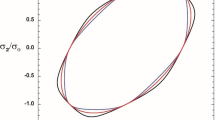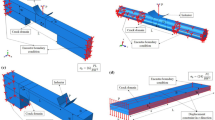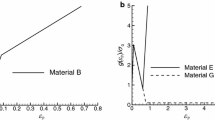Abstract
This article introduces a quasi-deformation plasticity theory which takes account of nonproportional loading by means of an orthotropic yield surface. The analysis is used to extend fracture mechanics concepts beyond the normal limits of J-integral theory. A simple correction for crack tip stresses is derived from the quasi-deformation assumption. This correction indicates that the degree of crack tip triaxiality is related to the relationship between the J-integral and the crack tip opening displacement (CTOD). Predictions of crack tip stress fields agree well with published finite element results.
The simple correction for crack tip fields is used in conjunction with micromechanical failure models for cleavage and microvoid coalescence to predict fracture toughness in large scale yielding. These analyses indicate that cleavage toughness is very sensitive to losses in triaxiality. Predictions for a center cracked panel, for instance, indicate that the effective driving force for cleavage may be significantly less than the apparent driving force. Resistance to crack initiation by microvoid coalesence is affected by constraint but it is not nearly as sensitive as cleavage resistance.
Résumé
L'article introduit la théorie de la plasticité sous déformations virtuelles qui prend en compte une mise en charge non proportionnelle au moyen d'une surface d'écoulement plastique orthotrope.
On utilise l'analyse par l'exclusion des concepts de mécanique de rupture au delà des limites normales de la théorie de l'intégrale J. Par l'hypothèse des déformations virtuelles, on déduit une correction simple pour les contraintes à l'extrémité de la fissure. Cette correction indique que le degré de triaxialité à l'extrémité de la fissure] est lié à la relation entre l'intégrale J et le CTOD. Les prévisions sur les champs de contraintes à l'extrémité de la fissure sont en bon accord avec les résultats par éléments finis qui sont publiés.
La correction simple pour des champs à l'extrémité d'une fissure est utilisée dans des modèles de rupture à l'échelle microscopique pour le clivage et la coalescence de micro-lacunes, en vue de prédire la ténacité à la rupture lors d'un écoulement plastique à grande échelle.
De telles analyses indiquent que la ténacité par rapport au clivage est très sensible à des pertes de triaxialité. Ainsi, par exemple, les prédictions relatives à un panneau fissuré en son centre, indiquent que la force entraînant effectivement le clivage peut être significativement moindre qu'il n'appert.
La résistance à l'amorcage d'une fissure sous l'effet d'une coalescence de micro-lacunes est affectée par le bridage, mais elle n'y est pas aussi sensible que la résistance au clivage.
Similar content being viewed by others
References
J.R. Rice, Journal of Applied Mechanics 35 (1968) 379–386.
H.A. Ernst, in ASTM STP 803, American Society for Testing and Materials, Philadelphia, PA (1983). I-191-I-213.
J.W. Hutchinson, Journal of the Mechanics and Physics of Solids 16 (1968) 13–31.
J.R. Rice and G.F. Rosengren, Journal of the Mechanics and Physics of Solids 16 (1968) 1–12.
R.A Begley and J.D. Landes, in ASTM STP 514, American Society of Testing and Materials, Philadelphia, PA (1972) 1–23.
J.D. Landes and R.A. Begley, ASTM STP 514, American Society of Testing and Materials, Philadelphia, PA (1972) 24–39.
A.A. Wells, Proceedings of the Crack Propagation Symposium, Vol. 1, Paper 84, Cranfield, UK (1961).
C.F. Shih, Journal of the Mechanics and Physics of Solids 29 (1981) 305–326.
R.M. McMeeking and D.M. Parks, ASTM STP 668, American Society of Testing and Materials, Philadelphia, PA (1979) 175–194.
C.F. Shih and M.D. German, International Journal of Fracture 17 (1981) 27–43.
E 813-87, Standard Test Method for J k, a Measure of Fracture Toughness, American Society for Testing and Materials, Philadelphia, PA (1987).
R.A. Schapery, International Journal of Fracture 25 (1984) 195–223.
V. Kumar, M.D. German and C.F. Shih, “An Engineering Approach for Elastic-Plastic Fracture Analysis,” Report NP-1931, Electric Power Research Institute, Palo Alto, CA (1981).
T.L. Anderson and D. Stienstra, Journal of Testing and Evaluation, 17 (1989) 46–53.
K. Wallin, Engineering Fracture Mechanics 19 (1984) 1085–1093.
T.L. Anderson, A Combined Statistical/Constraint model for the Ductile-Brittle Transition Region, Proceedings of the Third International Symposium on Nonlinear Fracture Mechanics, October 6–8, 1986, Knoxville, TN, to be published.
A.G. Evans, Metallurgical Transactions 14A (1983) 1349–1355.
T. Lin, A.G. Evans and R.O. Ritchie, Journal of the Mechanics and Physics of Solids 43 (1986) 477–497.
K. Wallin, T. Saario and K. Törrönen, Metal Science 18 (1984) 13–16.
F.M. Beremin, Metallurgical Transactions 14A (1983) 2277–2287.
Y. d'Escata and J.C. Devaux, ASTM STP 668, American Society of Testing and Materials, Philadelphia, PA (1979) 229–248.
D. Parks, “A Surface Crack Review: Elastic and Plastic Behavior,” Proceedings Symposium on Surface-Crack Growth: Models, Experiments, and Structures, April 25, 1988, Reno, NV.
W.G. Reuter and W.R. Lloyd, “Measurements of CTOD and CTOA Around Surface-Crack Perimeters and Relationships Between Elastic and Plastic CTOD Values,” Proceedings Symposium on Surface-Crack Growth: Models, Experiments, and Structures, April 25, 1988, Reno, NV.
R. Hill, Proceedings of the Royal Society 193 (1948) 281–297.
R.A. Schapery, “A Theory of Mechanical Behavior of Elastic Media With Growing Damage and Other Changes in Structure,” Technical Report MM 5762–88–1, Mechanics and Materials Center, Texas A&M University, College Station, TX (March 1988).
Author information
Authors and Affiliations
Rights and permissions
About this article
Cite this article
Anderson, T.L. Crack tip parameters for large scale yielding and low constraint configurations. Int J Fract 41, 79–104 (1989). https://doi.org/10.1007/BF00018479
Received:
Accepted:
Issue Date:
DOI: https://doi.org/10.1007/BF00018479




